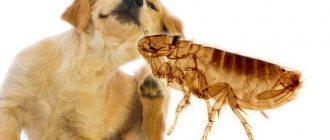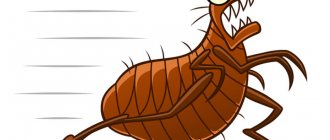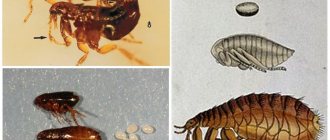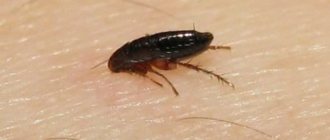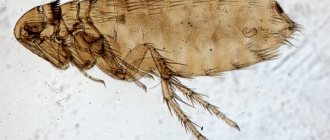Fleas in cats and dogs
Many pet owners mistakenly believe that if their pet does not go outside, then fleas are not scary for him.
Unfortunately, this is not entirely true. Let's first figure out what fleas are and what the routes of infection are. What types of fleas are there?
There are two types of fleas - “permanent”, that is, those that remain on the animal all the time and those that attack, bite, drink blood and then go back to their habitat. The latter are known as “grass fleas,” and they can live not only in the grass, but also in animal bedding, and even in a secluded corner under the baseboard. Their main feature is their temporary stay on the animal.
Grass fleas attack everyone indiscriminately - dogs, cats, rabbits, and people, while permanent fleas are often (but not always!) distinguished by selectivity, being more species-specific (cat fleas, fleas dogs, rabbit fleas, etc.)
Resident fleas, as a rule, are much inferior in jumping ability to their “grass” relatives, and infection with them occurs mainly during contact with a sick animal. At the same time, you can catch grass fleas almost anywhere, and even if the animal does not go outside at all, it is still at risk, since fleas can be brought into the house on a person’s shoes and clothing.
How dangerous are fleas and what are the symptoms of infection?
An animal of any age and breed can become infected with fleas. When infected, the animal becomes anxious, itches, and bites itself. When combing the fur, you can see the fleas themselves and their excrement, as well as the so-called “flea houses”.
In addition to the above signs, the clinical picture can be very different, since flea saliva contains many allergic components and different animals react to these components differently. Dermatitis with crusts and papules (vesicles), possibly symmetrical baldness on the abdomen or sides, and itching in the muzzle are often observed.
In addition, we must not forget that fleas can be carriers of helminths (worms) and other unpleasant diseases,
for example, hemobartenellosis.
Hemobartonellosis is an infectious disease that causes anemia in animals. In this disease, red blood cells are damaged. Parasites attach to the membrane, the erythrocyte, but they do not penetrate the membrane, but form a depression and remain in it. This infection is transmitted by a flea bite or through open wounds. Often this disease occurs without any special symptoms, but can appear after the animal has suffered stress.
As for helminthiases, these are primarily cucumber tapeworm and toxocara.
Toxocara is a disease of humans and animals. This is a roundworm that lives freely in the intestinal lumen. The larvae can pass through the intestinal wall and infect the lungs. Outwardly it manifests itself as a large, saggy belly with general thinness. May lead to the death of puppies. Intoxication is also particularly dangerous when these parasites die while taking anthelmintic drugs.
Cucumber tapeworm is a disease caused by a tapeworm that lives in the small intestine. This disease is very common in cats and dogs. An animal can get this disease by ingesting lice and flea larvae, as well as lice larvae. The larvae, having penetrated the intestine, attach to its wall and grow there up to one meter in length.
How to rid an animal of fleas?
Pet stores and veterinary pharmacies sell many different drugs:
- Shampoos and solutions for washing animals work well against existing parasites, but have an unstable effect, as a result of which they are not very suitable for preventing re-infection.
- Powders, sprays, preparations that are dripped onto the withers are used for both treatment and prevention. They are easy to use and have a lasting, long-lasting effect.
- Anti-flea collars are more suitable for preventing infection, but some animals may experience allergic reactions of varying severity when wearing such a collar. There are also cases where an animal was injured by getting caught in a collar.
When fleas are detected and treatment is carried out, it is also necessary to treat the apartment and the bed. The bedding is treated with a hot iron on both sides, wet cleaning is carried out and the room is treated with special preparations. An ampoule of this drug is diluted in two liters of water. With this solution you need to treat the area where the animal is: the rugs on which it lies, the floor itself, the carpet and other objects close to the animal. If an animal is diagnosed with fleas, it is possible that they may also have worms. Therefore, it is better for the animal to undergo preventive procedures against worms.
And, of course, it is important to remember that prevention is always better than cure, so from March to November you need to regularly treat the animal.
How to remove fleas from a pregnant or lactating dog?
Dogs can also often pick up fleas from walks and contact with other dogs. If your pet is pregnant or about to give birth to puppies, and you find fleas on her, you need to get help immediately.
Fleas on a pregnant dog
The main thing that the owner of a pregnant dog should understand is that there is no need to panic. Naturally, caring dog owners love their pets madly, and especially if they are breeding puppies, any disease can unsettle them.
Dogs usually have a positive attitude towards water, so you can use bathing shampoos . But be careful, if your dog is afraid of water, it is better not to use this method of protection and do not force him to get into the bathroom.
It is advisable to use anti-flea shampoo only if the dog is accustomed to bathing.
- Be careful when taking your dog or small puppies for a walk - fleas live long enough not only in fur, but also on the ground and asphalt
- And if a dog passed here in front of your pet, whose owner did not remove fleas, there is a fairly high probability that these parasites will migrate to your pet
- Therefore, after each walk, try to examine the dog for preventive purposes, and during pregnancy and nursing babies, put a collar on it.
It is also better to use biological collars , since their composition is absolutely safe for the expectant mother.
Be sure to consult with a veterinarian if the dog is pregnant and has fleas.
Thus, if your beloved dog has picked up parasites, and even being in an interesting situation, do not clutch your heart - visit a veterinary clinic and they will help you in choosing the optimal protection against fleas.
Fleas in cats and dogs are transmitted to humans: is this really true?
Many people have probably heard the assumption that fleas from pets can easily be transmitted to humans. In fact, this assumption is absolutely true. True, the word “transferred” does not quite fit this situation.
These tiny bloodsuckers do not care whose blood they drink: cats, dogs or humans. The only thing that prevents fleas from living on the human body is the lack of hair, which would serve as their natural protection. It is much easier for a bloodsucker to hide in the fur of the same cat or dog. Fleas are very unpleasant insects that can jump several meters with the help of their powerful legs. In addition, they easily bite through human skin and feed on blood. Their bites are accompanied by unpleasant sensations, and then severe itching.
Although the main “hosts” of fleas are domestic animals, they quite successfully parasitize the human body. Depending on the type of bloodsucker, the process of transmission of the insect to humans differs.
Flea transmission process
This is not the first time people who have animals such as cats and dogs in their homes have heard about fleas. As a rule, they can be picked up right in the house when animals return from the street or from an enclosure.
On a note
And the whole word “transmitted” is completely inappropriate for this situation due to the fact that a flea cannot parasitize on the human body. This word is appropriate in the phrase “disease transmission.” And yet the word transmitted is actively used in the context of fleas, even in scientific literature.
As soon as a flea bites an animal and drinks blood, it tries to find a secluded place where no one will disturb it, and it can easily lay eggs, from which new bloodsuckers will then hatch. The flea will remain there until it is again tormented by hunger.
When they urgently need a source of food, fleas make no difference who they attack, and if a person comes their way, they will attack him first.
Contrary to erroneous belief, fleas do not often jump from an animal directly to a person - they are much more comfortable feeding in thick fur, where a dog or cat can hardly reach it. However, science knows such a species as the human flea, which are created for living conditions on the human body.
Interesting
The most common fleas are cat fleas. They are the ones who most often bite both humans and cats. Interestingly, they are found on dogs even more often than dog fleas.
Bloodsuckers search for a new “master” using their well-developed sense of smell. The stronger the smell of an animal or person, the greater the chance that a flea will choose it.
Even more fleas live on wild animals - especially on foxes, which are very common in our latitudes. Therefore, during a hunt, when a person approaches an animal’s hole, he can be attacked by several dozen, or even hundreds of hungry individuals at once.
Where is the greatest risk of catching a flea?
In fact, a person can encounter this unpleasant insect anywhere. This could be his own house, his neighbors' house, a park where he went with his family for a picnic, and so on.
And yet, most often a person encounters them in a house where animals live. In addition, they do not have to be pets - rats, mice and yard animals also carry fleas. Even birds can be carriers of this parasite. According to statistics, 3/4 of all domestic animals had fleas on their bodies.
Review
I don't pay too much attention to my pets. However, recently, right in my own home, some insects began to bite me. Having caught one such bloodsucker, it became clear that these were fleas. The surprise was not too great, since the animals never wore special collars. After examination by a veterinarian, we learned that these were not even dog fleas, but cat fleas. Then I learned that fleas are not very particular about who they bite.
As a rule, a person is bitten in places where an animal infected with fleas rests and cleans its fur. This could be his kennel, bedding, or just the carpet, where fleas like to hide when they lay their larvae and hide until their next meal.
Dog fleas, which bite humans least often, attack when the person passes near a doghouse. It just so happens that female insects love to lay their eggs there, after which they become monstrously hungry and attack anyone who passes nearby.
You are also most likely to encounter these nasty bloodsucking insects in the following places:
- shelters of wild animals (burrows, hollows and nests), near which hunters and forestry workers constantly pass;
- farms are constantly infested with various types of fleas, even though they are constantly being fought against;
- Since fleas infest rodents that live in meadows in parks, sitting next to a hole on a picnic, people become their victims.
Fleas in the apartment
If your pet is infested with fleas, most likely fleas have already settled in your apartment. Fleas that parasitize pets can bite humans. Flea bites are not necessarily painful, but they often cause itching, which in itself is quite unpleasant.
Some people, as well as pets, are allergic to flea bites. Pay attention to your children, if they play on the floor, the likelihood of being bitten by fleas increases significantly.
As soon as you discover that there are fleas in your apartment, you need to immediately begin taking action to rid your home of these unpleasant insects.
How to get rid of fleas in an apartment
Vacuum all carpets and rugs in the apartment, as well as bedding and your pet's favorite places. Don't forget to change or thoroughly clean the dust container of your vacuum cleaner. Vacuum the areas most inhabited by animals every day. This will help get rid of not only fleas, but also their eggs and larvae.
Wash all of your pet's bedding periodically. Use special flea products to treat your pet's bedding that cannot be washed. Also treat carpets, chairs and other things and places where parasites are likely to live.
How to protect yourself from flea bites?
Pet owners should always be prepared for the possibility that their pets will interact with yard animals and pick up fleas. It is enough for only a few parasites to get on your pet’s fur, and after a while they will multiply into a small colony.
To prevent your home from becoming a habitat for small bloodsuckers, you must adhere to the following fairly simple rules:
- do not allow your pets to get close to yard animals, and also constantly check their fur for parasites;
- if they were nevertheless discovered, begin to destroy them at that very moment;
- Regular cleaning of your home with the addition of ammonia to the floor cleaner - fleas cannot stand it.
Animals should be treated with special drops, which can be purchased at veterinary pharmacies. You can find out which product is right for your pet by consulting a veterinarian.
Such simple prevention methods guarantee that not a single flea will bite you after jumping from a pet.
The situation when people become victims of bloodsucker bites while working directly next to the animals on which they live deserves a separate investigation. Such places may include zoos, farms and nurseries.
In this case, it is extremely reasonable to use special means to combat fleas. Now there is a huge variety of them. Aerosols are very effective. They are convenient to use both at home and on outdoor trips. They are completely harmless to the human body. But by spraying your skin with them, you can be sure that you will not be bothered by flea or even mosquito bites.
As a rule, many people complain of flea bites on their legs. Therefore, in order to protect yourself from such bites, this is especially effective in nature, you should wear thick pants and tuck them into your boots. In this way you can protect yourself from annoying insects. Tourists who spend a lot of time hiking in the wild should take this tip into account.
Thus, we learned that fleas feed not only on the blood of domestic animals, but also on human blood - it makes no difference to them what warm-blooded animal gets in their way. If fleas are detected, they must be destroyed as soon as possible. Itching is far from the worst thing they can bring. Much more dangerous are diseases that are transmitted with a bite.
How to remove fleas from a pregnant or lactating cat?
Removing fleas from a pregnant cat at home is quite a difficult task. Pregnant animals are especially sensitive to parasite bites and the itching from the bite remains for several days .
Therefore, in order to reduce the animal’s suffering, the owner needs to carry out a number of urgent medical measures.
Removing fleas from a pregnant cat is not so easy
The main thing that every owner needs to understand is that treatment for pregnant cats differs from standard flea treatment.
For them, you need to use more gentle methods. After all, ingestion of even a small amount of an insecticide spontaneous miscarriage or abnormal development of the fetus cannot be ruled out
It is important to understand that when feeding kittens, the mother should not have fleas, since the bites of these parasites cause severe itching and redness on the kitten’s fragile body. It is also possible that the baby may become infected with various bacteria and helminths . Sick animals lag behind in development and growth, grow weak and inactive.
A mother cat should not have fleas, because newborn kittens will suffer from them.
For the treatment of pregnant cats, the optimal remedy would be:
- Flea collar (safer to choose a biological one)
- Flea shampoo
- Flea drops (can only be prescribed after consultation with a veterinarian)
A flea collar is the safest remedy for treating parasites in a pregnant cat, since no medicinal drugs enter the skin or blood and this does not negatively affect the fetus.
A biological collar is especially safe , since it contains special essential oils that repel parasites with their smell.
The biological collar effectively fights and protects against parasites
When bathing, the animal may experience stress - not all cats love and are used to bathing. Therefore, if you know that your pet is not used to water treatments, it is better not to injure the cat and not to use shampoos for treatment.
Flea drops penetrate the skin and blood, so they are extremely undesirable for pregnant and lactating cats. It is better to consult a veterinarian before use, so as not to harm either the mother or the offspring.
Also, be sure to thoroughly clean the room to prevent the spread of parasites throughout the apartment.
If you use these tips, your cat will be safe from flea infestations, and the kittens will grow up healthy.


